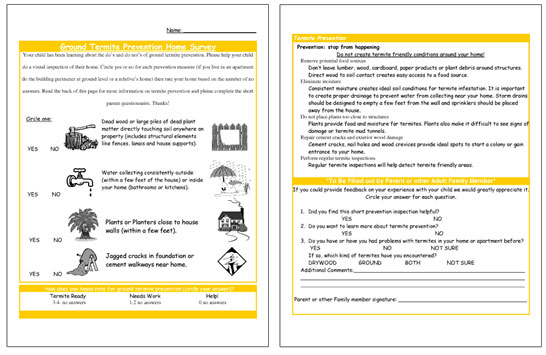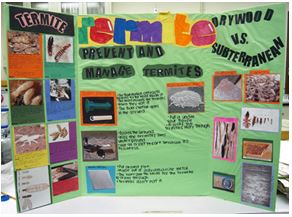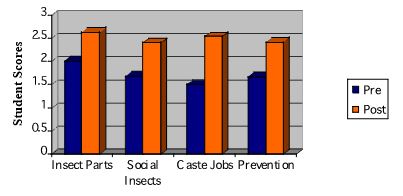 |
December 2013
|
December 2013 // Volume 51 // Number 6 // Research In Brief // v51-6rb5
Measuring the Impact of Termite Prevention Curricula in Hawaii Public Schools in an Area-Wide Extension Program
Abstract
The efficacy of Educate to Eradicate, a K-12 service-learning science curricula developed as part of a statewide, community-based Extension effort for termite prevention, was evaluated. The curricula use termite biology and control as the basis for science education and have been implemented in over 350 Hawaii public school classrooms with more than 12,530 students from 2001 to present. Student surveys and work samples were used to measure changes in student knowledge, behavior, and engagement. Use of school curricula in Extension programs reaches a large public audience and encourages long-term continuation of community pest prevention efforts.
Introduction
The Formosan subterranean termite (Coptotermes formosanus Shiraki) is the most economically significant insect pest in Hawaii, costing over $100 million annually in control and repair (Tamashiro, Yates, Yamamoto, & Ebesu, 1990). While area-wide pest management has been implemented in agricultural contexts (Elliott, Onstad, & Brewer, 2008), urban area-wide initiatives struggle to create and maintain stakeholder cohesion (Merritt, Kennedy, & Gersabeck, 1983; Fear, Simmons, Lambur, & Parks, 1983). One option to sustain area-wide termite control is through community education. The University of Hawaii Termite Project: Educate to Eradicate is a statewide Extension program intended to suppress termites through research and education (Grace, Yates, Aihara-Sasaki, & Lillich, 2007). Grade-specific Educate to Eradicate K-12 curricula were developed to reach Hawaii residents over a large geographic (statewide) area through public schools. The curricula have been implemented in over 350 Hawaii public school K-12 classrooms with over 12,530 students since 2001. It is designed to meet several Hawaii state science standards (HCPS III, 2007) utilizing termite biology, control, and prevention, while simultaneously extending information on effective termite prevention to the next generation of Hawaii homeowners and into the community through both direct assignments and the normal interactions of the students with caregivers and community members.
Educate to Eradicate curricula include the establishment of live termite habitats. These in vitro colonies are the catalyst for lessons on the scientific method, including data collection, predictions, and inquiry. Exposure to termite colonies motivates lessons on adaptation, communication, and interdependence. Subsequent lessons and investigations refine students' use of the scientific method while introducing termite lifecycles, prevention, and control content knowledge (Grace, Baumgartner, Yates, & Aihara-Sasaki, 2008). Student termite knowledge is transferred beyond the classroom into communities through Extension activities. Students inspect their own residences for termite hazards with parent/guardian participation using the subterranean termite prevention home survey (Figure 1). Partner teachers design culminating service-learning projects that require application of unit knowledge to community outreach activities (Figure 2). These activities vary based on student/school needs and have included community presentations using student made posters, pamphlets, websites, short stories, videos, songs, and letters. Home surveys and service-learning projects result in knowledge transfer from participating students to homeowners within the community (Lemus, Bishop, & Walters, 2010; Schmidt, Shummow, & Kackar, 2007). Activities in the schools are coupled with adult education evening seminars on termite prevention and control, offered by university research and extension entomologists.
Figure 1.
Subterranean Termite Prevention Home Survey Used by Students Grades K-6 During Home Inspections

Figure 2.
Example of Poster Created and Presented by a Participating Student During a Community Event

The Hawaii-based Educate to Eradicate Extension program was initiated as part of the national USDA-ARS Operation Full Stop program to combat the Formosan subterranean termite. Other research and Extension projects funded by this program focused on community-wide termite suppression in the French Quarter of New Orleans, Louisiana, (Guillot, Lax, Ring, Morgan, Brown, Riegel, & Boykin, 2010) and in the community of Golden Beach, Florida (Su, Ban, & Scheffrahn, 2004). Continuation of such efforts by community members once public funding ends is unlikely. Because termites are ubiquitous in Hawaii, we adopted a statewide approach rather than focusing on a single community within the state. We also chose to focus our efforts on intensive Extension education in termite prevention and control, integrated with normal school instructional practices and community activities, rather than committing funds directly to pest suppression. Our belief is that a well-informed public is more likely to continue to apply effective pest suppression techniques than a more passive audience that has relied on organization and funding of the pest management activities by a public agency. Sustainability of this Extension initiative post-funding by molding the curricula to encourage permanent adoption by public school teachers was a key component of the project (Mason, Aihara-Sasaki, & Grace, 2013).
In 2011, a formative evaluation of Educate to Eradicate was performed to assess the impact of participation on student knowledge, skills, and behaviors. Student surveys were chosen to evaluate curricula efficacy because surveys can be administered anonymously and gather large amounts of data quickly and are easily built into classroom instruction (Creswell, 2005). Student and participant pre/post-surveys are commonly used to evaluate Extension curriculum efficacy (Kelsey, Schnelle, & Bolin, 2005; Jensen, Kattlemann, Ren, & Wey, 2009; Diem 2001; Jones, Nobles, & Larke, 2006). Findings were used to strengthen the development of self-sustaining curricula requiring limited university inputs.
Methods
All participating students attended Hawaii public schools (Oahu: 28, Maui: 2, Hawaii: 1). Changes in student knowledge, skills, and behaviors were measured with student surveys. Surveys ranged from six to 28 questions depending on curricula grade-level objectives. Subterranean termite prevention home surveys were created to document student extension efforts and behaviors.
As part of classroom instruction, partner teachers read concept surveys out loud as students recorded their responses. Pre-concept surveys were completed within 1 week prior to curriculum implementation and post-concept surveys within 2 weeks of project completion. A total of 5,192 paired-surveys were received from students in grades 1-12 from 2001 to 2011 (48% return rate). Percentages of item responses were compared before and after participation in Educate to Eradicate curricula. Classroom mean pre-/post-concept survey scores were compared with paired t-tests.
Student survey data from 92 teachers across 31 schools were combined as split plots to assess curricula performance across a range of conditions. All grade levels were surveyed on insect parts, characteristics of social insects, jobs performed by different termite castes, and termite prevention (Figure 3). Effects of school, teacher, curricula, and years of teacher participation (covariate) on student learning were evaluated with ANOVA (SAS software, Version 9.2, PROC GLM linear model) (Tables 1-4).
Figure 3.
Student Knowledge Before and After Educate to Eradicate Curricula. All Grade Levels Combined Across Four Prompts.

| Source | df | Mean Square | F | p |
| School | 30 | 14.2 | 7.5 | <0.0001 |
| Teacher (School) | 63 | 1.9 | 5.4 | <0.0001 |
| Curriculum | 1 | 296.8 | 18.6 | 0.0002 |
| Curriculum X School | 30 | 16.0 | 45.1 | <0.0001 |
| Years of Teacher Participation | 1 | 0.008 | 0.02 | 0.09 |
| Source | df | Mean Square | F | p |
| School | 30 | 6.0 | 2.2 | 0.004 |
| Teacher (School) | 63 | 2.7 | 6.2 | <0.0001 |
| Curriculum | 1 | 335.0 | 19.5 | 0.0001 |
| Curriculum X School | 30 | 17.2 | 39.3 | <0.0001 |
| Years of Teacher Participation | 1 | 0.3 | 0.7 | 0.4 |
| Source | df | Mean Square | F | p |
| School | 30 | 3.3 | 1.6 | 0.06 |
| Teacher (School) | 63 | 2.1 | 5.6 | <0.0001 |
| Curriculum | 1 | 650.7 | 26.7 | <0.0001 |
| Curriculum X School | 30 | 24.4 | 64.8 | <0.0001 |
| Years of Teacher Participation | 1 | 0.9 | 2.3 | 0.1 |
| Source | df | Mean Square | F | p |
| School | 30 | 2.5 | 1.1 | 0.3 |
| Teacher (School) | 63 | 2.2 | 4.8 | <0.0001 |
| Curriculum | 1 | 385.6 | 18.5 | 0.0002 |
| Curriculum X School | 30 | 20.9 | 45.9 | <0.0001 |
| Years of Teacher Participation | 1 | 1.4 | 3.0 | 0.08 |
As a culminating activity, students survey their homes with parents/guardians, searching for termite signs and/or termite-conducive conditions. Students use a subterranean termite prevention home survey for the inspection, which includes an area for parent/guardian feedback and signature. Return and signature rates were tallied during the 2010-2011 school year.
An unavoidable shortcoming of the research reported here was that not all surveys were returned by teachers. These omissions sometimes included missing documentation from entire classrooms. Other reasons for omission included student movement between schools and absenteeism. Our analysis assumes that unreturned surveys were randomly distributed.
Results
Students reported significant gains in content knowledge across all but one assessed parameter. Middle and high school students reported the largest gain in their ability to name and describe termite caste members' jobs (63% increase) and indicated significant gains in all concept survey prompts (16%-63% increases). In addition to a concept survey, middle and high school students rated their command of unit-specific vocabulary. Students showed significant increases in vocabulary scores for all terms. The largest mean survey score increase (48%) was found for "frass" (drywood termite fecal pellets). Middle school English language learners (students learning English in addition to their native language[s]) and special education classrooms reported significant gains (30%- 43%) across all prompts other than "I can make scientific observations using words and pictures." First- through fifth-grade students' mean survey scores increased significantly across all prompts (7%-40%). The largest gains across all grade levels were in the ability to name termite caste members and describe caste jobs (40%). The smallest change was reported for "I can make scientific observations using words and pictures."
Participation in Educate to Eradicate curriculum had a significant effect on student scores. Average pre-survey responses to the prompt "I can list the six prevention steps scientists suggest my parents take to keep worker termites from damaging our home" fell between "Not Really" and "I Think So," at 1.7. After curriculum participation, the average response was between "I Think So" and "Yes," at 2.4.
Curricula had a significant positive effect on student scores across all four prompts. Teachers and curriculum/school interactions were found to have significant, but inconsistent, relationships on individual survey questions. School had significant impacts on responses to insect parts and social insects, but not on termite caste jobs or prevention. Educator experience with curriculum was not associated with learner outcomes across all four prompts.
The subterranean termite prevention home survey was returned by 86% of 2010-2011 students. Of those returned, 74% were signed by a parent/guardian.
Discussion
Students showed significant knowledge gains across most content prompts. The one prompt that did not have significant mean increases still reflected increases in student confidence. The percentage of English language learners and special education middle school students who responded "Yes" to "I can make scientific observations using words and pictures" increased from 36.1% to 56.6%. Scientific observation is an ongoing performance standard taught at all grade levels (HCPS III, 2007). Additionally, students within this group participated in Educate to Eradicate curriculum during the second semester of the school year. Prior to the Educate to Eradicate unit, students had completed lessons and laboratories that incorporated scientific observation. While increases in student confidence were identified, relatively high prior ability to record scientific observations was reflected in the survey data.
Middle and high school students reported the largest gains in the terms "frass," "decomposer," and "subterranean." "Frass" is a unique entomological term that describes the termite droppings Hawaii students encounter. Linking vocabulary to a familiar sight may account for large gains in vocabulary acquisition. All groups reported the largest gains in their ability to name and describe the jobs of termite caste members. Students had the lowest prior knowledge of this prompt and the largest subsequent gains. These gains could be attributed to the lessons' connection to the Hawaii "structure and function in organisms" standard, extensive curricula reinforcement activities, and innate student interest. Observed increases from pre- to post-concept surveys were within the range reported in similar assessments of extension curricula (Boleman & Burrell, 2003; Hoover, Martin, & Litchfield, 2009; Van Offelen, Schroeder, Leines, Roth-Yousey, & Reicks, 2011).
In addition to significant increases in unit-specific knowledge, students demonstrated changes in behaviors. Similar to results reported by Webster (2006), students demonstrated changes in behaviors by conducting service learning activities, including the creation of pest prevention presentations, posters, websites, pamphlets, and songs. Students then documented their sharing of pest prevention media with adult community members. Additionally, all participating students were assigned the subterranean termite prevention home surveys as an extension of classroom instruction. During the 2010-2011 school year, 86% of participating students performed home inspections with guardians and returned completed surveys, with 74% signed by a parent/guardian.
Student survey data indicated significant impacts on student learning based on pre- and post-concept surveys. These gains were most significant within termite-specific content knowledge. Students demonstrated a change in behavior by inspecting their homes for signs of termites and termite-conducive conditions. We believe the immediate real-world application of student knowledge increased the program's efficacy, extended the knowledge gained to caregivers, and helped to embed both an awareness of termites and of proper pest prevention and management techniques in communities across the State of Hawaii.
Acknowledgments
We thank the teachers and students who partner with the University of Hawaii Termite Project: Educate to Eradicate, and we are grateful to Julian R. Yates, III, and Jari Sugano for helpful comments on early drafts of this article. Preliminary results were reported at the National Conference on Urban Entomology (2012). Study design, procedures, and instruments were approved by the University of Hawaii Committee on Human Subjects (CHS#18356). This project was funded through USDA-ARS Specific Cooperative Agreements 58-6435-3-087 and 58-6435-8-294, and by Hatch, McIntire-Stennis and Smith-Lever funds administered by the College of Tropical Agriculture and Human Resources.
References
Boleman, C. T., & Burrell, F. (2003). Agricultural science fairs: Are students truly learning from this activity? Journal of Extension [On-line], 41(3) Article 3RIB4. Available at: http://www.joe.org/joe/2003june/rb4.php
Creswell, J. W. (2005). Educational research: planning, conducting, and evaluating quantitative and qualitative research (2nd ed.). Upper Saddle River, NJ: Pearson Education.
Diem, K. G. (2001). National 4-H school enrichment survey. Journal of Extension [On-line], 39(4) Article 5RIB6. Available at: http://www.joe.org/joe/2001october/rb6.php
Elliott, N. C., Onstad, D. W., & Brewer, M. J. (2008). History and ecological basis for areawide pest management. In Koul, Cuperus, & Elliot (Eds,), Areawide pest management: Theory and implementation. CAB International, Wallingford, Oxfordshire, UK.
Fear, F. A., Simmons, G. A., Lambur, M. T., & Parks, B. (1983). A community development approach to IPM: anatomy of a pilot effort to transfer IPM Information on outdoor vegetation to suburban homeowners. In Frankie & Kohler (Eds.), Urban entomology: Interdisciplinary perspectives. Praeger, New York.
Grace, J. K., Baumgartner, E., Yates, J. R., & Aihara-Sasaki, M. (2008). No termite left behind: Meeting benchmarks with insect science. Proceedings of the 2008 National Conference on Urban Entomology (S. C. Jones, Ed.), Tulsa, OK. 30-32.
Grace, J. K., Yates, J. R., Aihara-Sasaki, M., & Lillich, G. (2007). Community education for better termite control in Hawaii. Proceedings Hawaiian Entomological Society, 39(1), 139–142.
Guillot, F. S., Lax, A. R., Ring, D. R., Morgan, A., Brown, K., Riegel, C., & Boykin, D. L. (2010). Area-wide management of the Formosan subterranean termite, Coptotermes formosanus, Shiraki (Isoptera: Rhinotermitidae) in the New Orleans French Quarter. Sociobiology. 55(2): 311-338.
Hawaii Content & Performance Standards III Database (2007). Hawaii Department of Education. Retrieved from: http://standardstoolkit.k12.hi.us/index.html
Hoover, J. R., Martin, P. A., & Litchfield, R. E. (2009). Qualitative tools to examine EFNEP curriculum delivery. Journal of Extension [On-line], 47(3) Article 3FEA3. Available at: http://www.joe.org/joe/2009june/a3.php
Jensen, B., Kattlemann, K., Ren, C., & Wey, H. (2009). The efficacy of KidQuest: A nutrition and physical activity curriculum for 5th and 6th grade youth. Journal of Extension [On-line], 47(3), Article 3FEA4. Available at: http://www.joe.org/joe/2009june/a4.php
Jones, W. A., Nobles, C. J., & Larke A. (2006). The effectiveness of a public nutrition education and wellness system program. Journal of Extension [On-line], 44(3), Article 3RIB5. Available at: http://www.joe.org/joe/2006june/rb5.php
Kelsey, K. D., Schnelle, M., & Bolin, P. (2005). Increasing educational impact: A multi-method model for evaluating extension workshops. Journal of Extension [On-line], 43(3), Article 3FEA4. Available at: http://www.joe.org/joe/2005june/a4.php
Lemus, J. D., Bishop K., & Walters, H. (2010). QuikSCience: effective linkage of competitive, cooperative, and service learning in science education. American Secondary Education. 38(3): 40-61.
Mason, M., Aihara-Sasaki, M., & Grace, J. K. (2013). Teacher characteristics and perceptions of pest management curricula: clues to adoption and continuation. Insects. 4(2): 177-184.
Merritt, R. W., Kennedy, M. K., & Gersabeck, E. F. (1983). Integrated pest management of nuisance and biting flies in a Michigan resort; dealing with secondary pest outbreaks. In Frankie & Kohler (Eds.), Urban entomology: Interdisciplinary perspectives. Praeger, New York.
Schmidt, J. A., Shummow, L., & Kackar, H. (2007). Adolescents' participation in service activities and its impact on academic, behavioral, and civic outcomes. Journal of Youth Adolescence. 36(2): 127-140.
Su, N.-Y., Ban, P., & Scheffrahn, R. H. (2004). Use of a bait impact index to assess the effects of bait application against populations of the Formosan subterranean termite (Isoptera: Rhinotermitidae) in a large area. Journal of Economic Entomoly. 97(6): 2029-2034.
Tamashiro, M., Yates, J. R., Yamamoto, R. T., & Ebesu, R. H. (1990). Longevity and efficiency of termiticides in Hawaii. Res. Ext. Series, HITAHR, University of Hawaii.
Van Offelen, S. J., Schroeder, M. M., Leines, D. R., Roth-Yousey, R., & Reicks, M. M. (2011). Go wild with fruits and veggies: Engaging children in nutrition education and physical activity with animal characters. Journal of Extension [On-line], 49(2), Article 2RIB6. Available at: http://www.joe.org/joe/2011april/rb6.php
Webster, N. (2006). Incorporating service learning and Extension in inner city middle schools: A model for future programming. Journal of Extension [On-line], 44(1), Article 1IAW1. Available at: http://www.joe.org/joe/2006february/iw1.php




